Romantic nationalism
| Part of a series on |
| Nationalism |
|---|
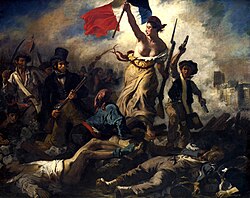
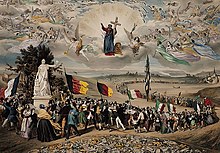
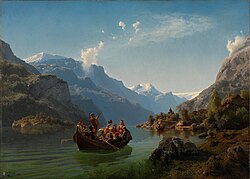
Romantic nationalism (also national romanticism, organic nationalism, identity nationalism) is the form of
Among the key themes of Romanticism, and its most enduring legacy, the cultural assertions of romantic nationalism have also been central in post-Enlightenment art and political philosophy. From its earliest stirrings, with their focus on the development of national languages and folklore, and the spiritual value of local customs and traditions, to the movements that would redraw the map of Europe and lead to calls for self-determination of nationalities, nationalism was one of the key issues in Romanticism, determining its roles, expressions and meanings. Romantic nationalism, resulting from this interaction between cultural production and political thought, became "the celebration of the nation (defined in its language, history and cultural character) as an inspiring ideal for artistic expression; and the instrumentalization of that expression in political consciousness-raising".[3]
Historically in Europe, the watershed year for romantic nationalism was 1848, when
Brief history
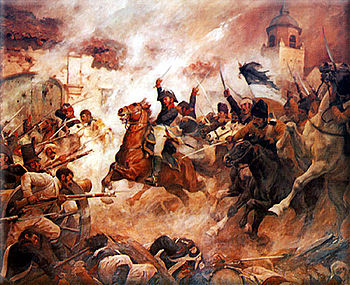
The ideas of
From its beginnings in the late 18th century, romantic nationalism has relied upon the existence of a historical ethnic culture which meets the romantic ideal; folklore developed as a romantic nationalist concept. The Brothers Grimm, inspired by Herder's writings, put together an idealized collection of tales, which they labeled as authentically German. The concept of an inherited cultural patrimony from a common origin rapidly became central to a divisive question within romantic nationalism: specifically, is a nation unified because it comes from the same genetic source, that is because of race, or is the participation in the organic nature of the "folk" culture self-fulfilling?[citation needed]
Romantic nationalism formed a key strand in the philosophy of
In continental Europe, Romantics had embraced the
Fichte expressed the unity of language and nation in his thirteenth address "To the German Nation" in 1806:
- The first, original, and truly natural boundaries of states are beyond doubt their internal boundaries. Those who speak the same language are joined to each other by a multitude of invisible bonds by nature herself, long before any human art begins; they understand each other and have the power of continuing to make themselves understood more and more clearly; they belong together and are by nature one and an inseparable whole. (Kelly, 1968, pp. 190–91)
- Only when each people, left to itself, develops and forms itself in accordance with its own peculiar quality, and only when in every people each individual develops himself in accordance with that common quality, as well as in accordance with his own peculiar quality-then, and then only, does the manifestation of divinity appear in its true mirror as it ought to be; and only a man who either entirely lacks the notion of the rule of law and divine order, or else is an obdurate enemy thereto, could take upon himself to want to interfere with that law, which is the highest law in the spiritual world! (Kelly, 1968, pp. 197–98)
Nationalism and revolution
In the Balkans, Romantic views of a connection with classical Greece, which inspired
Conservatism and revolution in the 19th century
Following the ultimate collapse of the
The conservative forces held sway until the
Folk culture
Romantic nationalism inspired the collection of folklore by such people as the Brothers Grimm. The view that fairy tales, unless contaminated from outside literary sources, were preserved in the same form over thousands of years, was not exclusive to Romantic Nationalists, but it fit in well with their views that such tales expressed the primordial nature of a people.[citation needed]
The
The work of the Brothers Grimm influenced other collectors, both inspiring them to collect tales and leading them to similarly believe that the fairy tales of a country were particularly representative of it, to the neglect of cross-cultural influence. Among those influenced were the Russian Alexander Afanasyev, the Norwegians Peter Christen Asbjørnsen and Jørgen Moe, and the Australian Joseph Jacobs.[9]
National epics
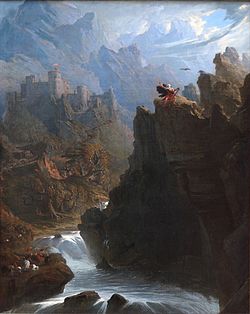
The concept of a "
The first publication of
Many other "national epics", epic poetry considered to reflect the national spirit, were produced or revived under the influence of Romantic nationalism: particularly in the Russian Empire, national minorities seeking to assert their own identities in the face of Russification produced new national poetry – either out of whole cloth, or from cobbling together folk poetry, or by resurrecting older narrative poetry. Examples include the Estonian Kalevipoeg, Finnish Kalevala, Polish Pan Tadeusz, Latvian Lāčplēsis, Armenian Sasuntzi Davit by Hovhannes Tumanyan, Georgian The Knight in the Panther's Skin and Greater Iran, Shahnameh.
German Romantic nationalism
The Romantic movement was essential in spearheading the upsurge of
The
Of this phenomenon, the Soviet literary scholar Naum Berkovsky wrote:
Görres, Arnim and Schelling began to create truly German national literature on the basis of German medieval art, religion and patriotism.[14]
This made scholars and critics like Fritz Strich, Thomas Mann and Victor Klemperer, who before the war were supporters of Romanticism, to reconsider their stance after the war and the Nazi experience and to adopt a more anti-Romantic position.[15]
Forgive, O
I do not possess a wise soul
Like you, and I have little patience,
So, please, come back soon, after all!
Retain the old methods of punishment,
If you judge the guillotine unpleasant:
The sword for the nobleman, and the cord
For the townsman and vulgar peasant.
But, do switch things around, now and then:
Peasants and townsmen should die by the sword,
And noblemen should hang on a rope.
We’re all the creatures of the Lord!
Bring back the laws of Charles the Fifth,
With the hanging courts restoration,
And divide the people, as before,
Into guild, estate and corporation.
Restore the old
As it was, whole and immense.
Bring back all its musty junk,
And all its foolish nonsense.
The Middle Ages I’ll endure,
If you bring back the genuine item;
Just rescue us from this bastard state,
And from its farcical system,
From that mongrel chivalry,
Such a nauseating dish
Of Gothic fancies and modern deceit,
That is neither flesh nor fish.
Shut down all the theatres,
And chase their comedians pack,
Who parody the olden days.
O, Emperor, do come back![16][17][18]
Arts
After the 1870s "national romanticism", as it is more usually called, became a familiar movement in the arts. Romantic musical nationalism is exemplified by the work of Bedřich Smetana, especially the symphonic poem "Vltava". In Scandinavia and the Slavic parts of Europe especially, "national romanticism" provided a series of answers to the 19th-century search for styles that would be culturally meaningful and evocative, yet not merely historicist. When a church was built over the spot in St Petersburg where Tsar Alexander II of Russia had been assassinated, the "Church of the Savior on Blood", the natural style to use was one that best evoked traditional Russian features (illustration, left). In Finland, the reassembly of the national epic, the Kalevala, inspired paintings and murals in the National Romantic style that substituted there for the international Art Nouveau styles. The foremost proponent in Finland was Akseli Gallen-Kallela (illustration, below right).
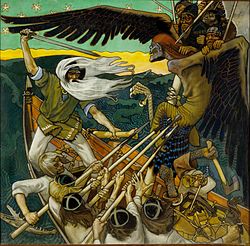
By the turn of the century, ethnic
tongues also experienced a poetic revival.Claims of primacy or superiority
At the same time, linguistic and cultural nationality, colored with pre-genetic concepts of race, bolstered two rhetorical claims used to this day: claims of primacy and claims of superiority. Primacy is the claimed
Twentieth-century political developments
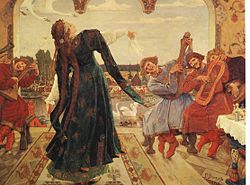
In the first two decades of the 20th century, Romantic Nationalism as an idea was to have crucial influence on political events. Following the Panic of 1873 that gave rise to a new wave of antisemitism and racism in the German Empire politically ruled by an authoritarian, militaristic conservatism under Otto von Bismarck and in parallel with the Fin de siècle (which was also reflected to a degree in the contemporary art movements of symbolism, the Decadent movement, and Art Nouveau), the racialist völkisch movement which grew out of romantic nationalism in Germany in the late 19th century.[20]
The rising nationalistic and imperialistic tensions between the European nations throughout the Fin de siècle period eventually erupted in the
Outside of Germany, the belief among European powers was that nation-states forming around unities of language, culture and ethnicity were "natural" in some sense. For this reason President
See also
- Chosen people / People of God
- Jews as the chosen people
- Conservatism
- Scandinavism
- Norwegian romantic nationalism
- Danish Golden Age
- German question
- Gothicism
- Hindutva
- Pochvennichestvo
- Britishness
- Ethnic nationalism
- Civil religion
- Polytheistic reconstructionism
- National epic
- National treasure
- National anthem
- Nationalism
- Patriotism
- Rise of nationalism in Europe
- Historiography and nationalism
- Musical nationalism
Sources
- ^ Joseph Theodoor Leerssen, Anne Hilde van Baal, and Jan Rock, eds. Encyclopedia of romantic nationalism in Europe (Amsterdam University Press, 2018.)
- ^ Joep Leerssen, "Notes toward a Definition of Romantic Nationalism." Romantik: Journal for the study of Romanticisms 2.1 (2013): 9-35. online
- ^ Joep Leerssen, "Notes towards a Definition of Romantic Nationalism", Romantik: Journal for the Study of Romanticisms, 2.1 (2013): 9-25 (28).
- ^ King, Brian (2016). "Herder & Human Identity". Philosophy Now (112). Retrieved 2 September 2018.
- ^ Miroslav Hroch, "Introduction: National romanticism", in Balázs Trencsényi and Michal Kopeček, eds. Discourses of collective identity in Central and Southeast Europe, vol. II National Romanticism: The Formation of National Movements, 2007:4ff.
- ^ Oscar Julius Falnes, National romanticism in Norway, 1968.
- ISBN 0-691-06722-8
- ISBN 0-393-97636-X
- ISBN 0-393-97636-X
- ^ The section "III.Early National Poetry" of The Cambridge History of English and American Literature (1907–21) begins "By far the most important product of the national epos is Beowulf...
- ^ Moshe Halbertal (1997), People of the Book: Canon, Meaning, and Authority, p.132: "With the rise of Jewish nationalism, the relation of many Jews to the Bible and the Talmud took another turn. The Zionists preferred the Bible to the Talmud as the national literature, for the Bible tells a heroic story of the national drama whose focus is the Land of Israel. While they objected to the Haskalah politics of emancipation, Zionist thinkers also stressed the role of the Bible, but they thought of it as an element in building a particular national consciousness rather than as the basis of a shared Judeo-Christian heritage enabling the integration of Jews in Europe. Unlike the Talmud, they held, the Bible had the potential to become a national epic. Its drama unfolded in the hills of Judea, and it connected the national claim to the land with a historical past. Nothing in the Talmud, in contrast, appealed to the romanticism vital to national movements. It does not tell the glorious story of a nation, it has no warriors and heroes, no geography which arouses longing in the reader or a sense of connection to an ancient home."
- ^ Rosenberg, Alfred (1982) [1930]. "Book I: The Conflict of Values, Chapter I. Race and Race Soul" (PDF). The Myth of the Twentieth Century: An Evaluation of the Spiritual-Intellectual Confrontations of Our Age. Translated by Bird, Vivian. Torrance, California: Noontide Press.
- ISBN 9780313295164.
- ^ Berkovsky, Naum Yakovlevich (1935). "От издательства" (PDF). Немецкая романтическая повесть. Том I. Moscow and Leningrad: Academia.
- ^ "Reactionary German Romanticism". Anasintaxi Newspaper, issue 385. 2013.
- ^ Heine, Heinrich (2007) [1844]. "Caput XVII". Germany. A Winter's Tale. Translated by Bowring, Edgar Alfred. New York: Montial.
- ^ Lukács, György (1980) [1952]. "Schelling's Later Philosophy" (PDF). The Destruction of Reason. Translated by Palmer, Peter R. London: Merlin Press.
- ^ Lukács, György (1947). "Romanticism (Die Romantik als Wendung in der deutschen Literatur)". Fortschritt und Reaktion in der deutschen Literatur. Translated by P., Anton. Berlin: Aufbau-Verlag.
- ^ Wagner, Das Judenthum in der Musik 1850.
- ISSN 1749-8171.
- Adam Zamoyski; Holy Madness: Romantics, Patriots and Revolutionaries 1776-1871; (Weidenfeld & Nicolson, 1999);
- Johann Gottlieb Fichte, Thirteenth Address, Addresses to the Gerrnan Nation, ed. George A. Kelly (New York: Harper Torch Books, 1968).
- Encyclopedia of Romantic Nationalism in Europe, ed. ISBN 9789462981188
External links
- Encyclopedia of Romantic Nationalism in Europe, a project by the Study Platform on Interlocking Nationalisms [1].
- "Encyclopedia of 1848 Revolutions", comprehensive collection of new articles by modern scholars
